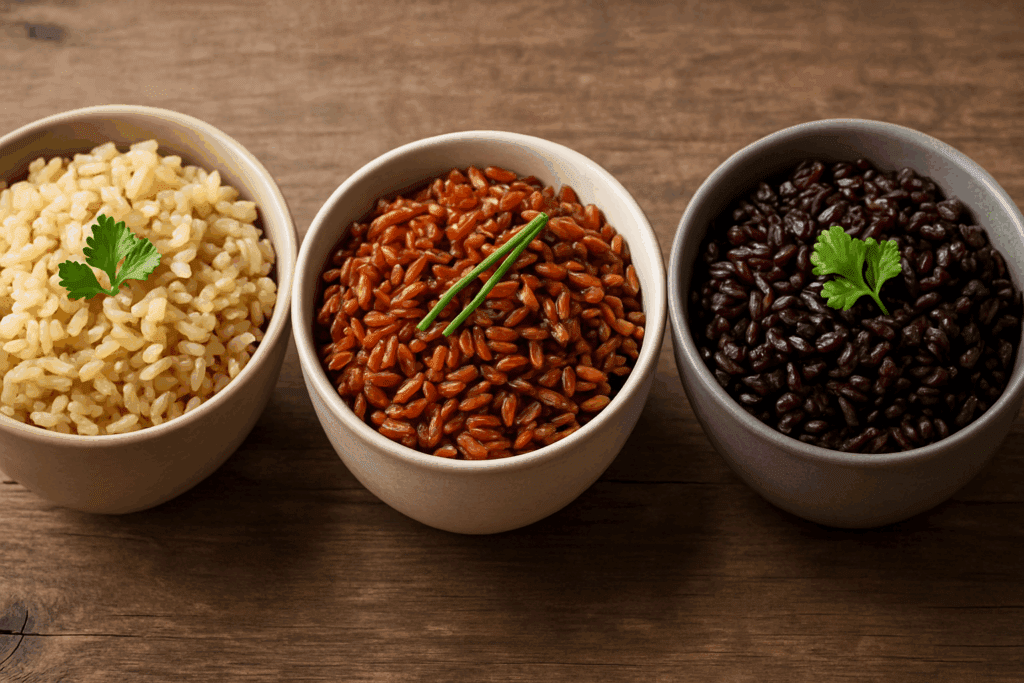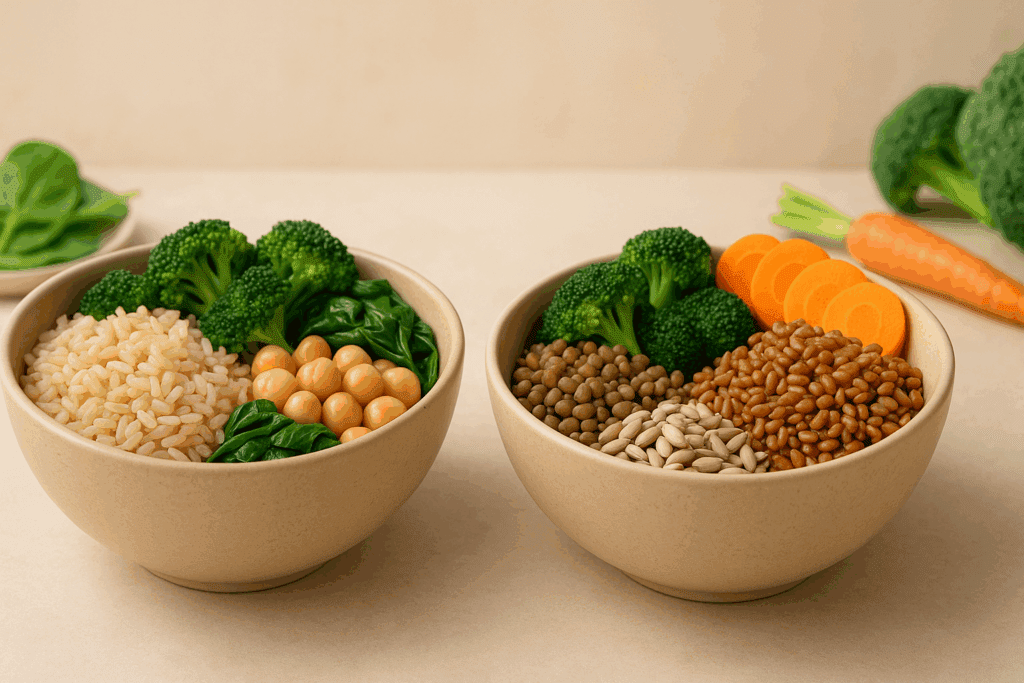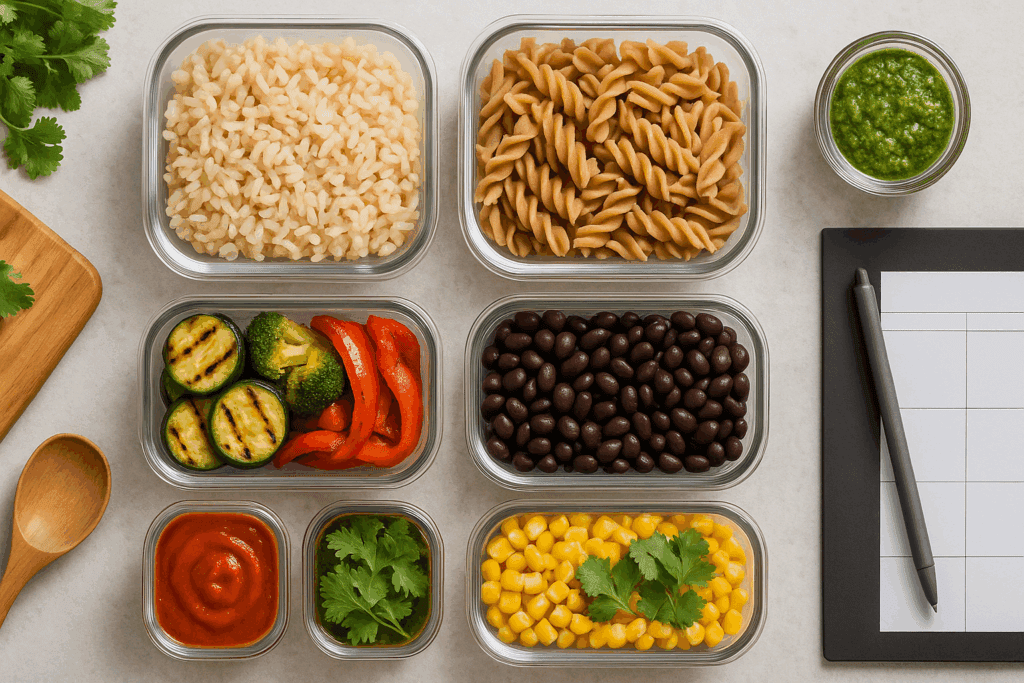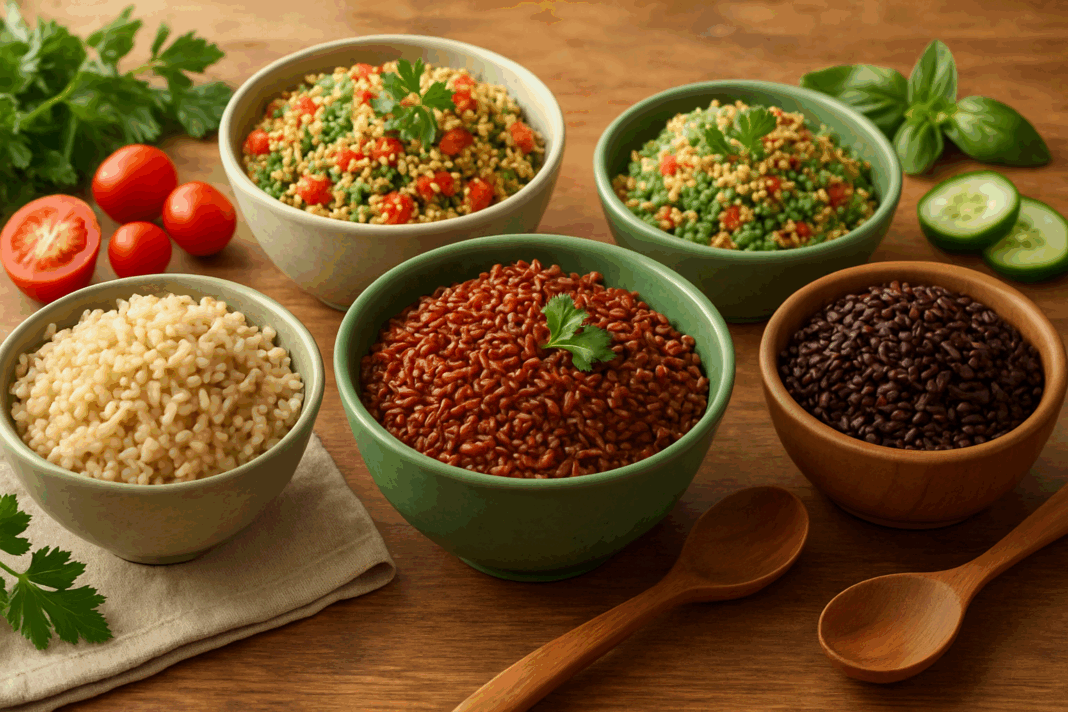In the modern pursuit of better health and wellness, nutrition has taken center stage as a key pillar in preventing chronic illness and supporting everyday vitality. Whole grains, especially whole grain rice and whole wheat rice, are increasingly recognized as fundamental staples for those seeking a nutrient-rich, balanced lifestyle. These grains offer more than just caloric energy—they provide a symphony of vitamins, minerals, and fibers essential to long-term wellness. Yet, despite their popularity, many consumers are still uncertain about the differences between whole grain rice and whole wheat rice, and how to incorporate them effectively into a healthy diet.
Both grains are celebrated for their nutritional density and positive impact on digestion, blood sugar regulation, and satiety. But to make smart nutrition choices, it’s crucial to understand what each grain offers in terms of health benefits, dietary compatibility, and culinary versatility. This article explores the science-backed distinctions and practical applications of whole grain rice and whole wheat rice to help you craft a more informed, sustainable approach to eating.
You may also like: How a Whole Foods Diet Supports Sustainable Weight Loss: Expert Tips for Eating Whole Foods to Lose Weight Safely

Understanding the Nutritional Foundation of Whole Grains
Whole grains are grains that retain their original three-part structure: the bran, germ, and endosperm. Unlike refined grains, which are stripped of the bran and germ during processing, whole grains maintain these nutrient-rich components, offering a robust nutritional profile. This includes dietary fiber, B vitamins, magnesium, selenium, and a host of phytochemicals with antioxidant properties. Regular consumption of whole grains has been linked to a lower risk of cardiovascular disease, type 2 diabetes, and colorectal cancer.
Whole grain rice and whole wheat rice each fall under this umbrella, yet they differ in subtle but important ways. Whole grain rice—often brown, red, or black rice—remains intact after milling and offers a mild, earthy flavor and chewy texture. Whole wheat rice typically refers to cracked or parboiled whole wheat grains, processed into rice-sized pieces. Though different in origin, both serve as powerful tools in building balanced meals that nourish and satisfy.

Whole Grain Rice: A Closer Look at Brown, Red, and Black Rice
Among the most popular types of whole grain rice is brown rice, followed by less common but increasingly appreciated varieties like red rice, black rice, and wild rice. These rice types differ slightly in taste and nutrient content but all share a common characteristic: they are minimally processed and retain their fiber-dense outer layers. This outer bran layer is a rich source of magnesium, phosphorus, and plant lignans, compounds known to support heart health and reduce inflammation.
Brown rice is widely available and known for its versatility and pleasant nutty flavor. It serves as a staple in countless cuisines worldwide, from Asian stir-fries to Latin American rice and beans. Red rice contains anthocyanins, the same antioxidant compounds found in blueberries, which contribute to its reddish hue and anti-inflammatory benefits. Black rice, sometimes called “forbidden rice,” boasts one of the highest antioxidant levels of any rice variety, making it a particularly health-boosting choice.
Beyond taste and color, whole grain rice also supports metabolic health by offering a lower glycemic index compared to white rice. This slower digestion leads to more stable blood sugar levels, making it ideal for people managing diabetes or looking to maintain consistent energy levels throughout the day.

Whole Wheat Rice: Dense in Fiber, Rich in Flavor
The term “whole wheat rice” can be confusing, as it refers to whole wheat kernels that are processed into a rice-like form, such as bulgur or cracked wheat. Unlike traditional rice, which is derived from the Oryza species, whole wheat rice comes from the Triticum family—the same source as whole wheat flour and pasta. Despite their botanical differences, both grains are considered complex carbohydrates and deliver sustained energy, thanks to their fiber content.
Whole wheat rice is particularly high in insoluble fiber, which supports digestive regularity and contributes to prolonged satiety after meals. It also contains important micronutrients like iron, zinc, and vitamin B6, which are crucial for immune function and red blood cell formation. The slightly coarse texture and nutty flavor of whole wheat rice make it a satisfying component in hearty salads, Mediterranean dishes, and pilafs.
This grain also has a slight advantage in protein content compared to most rice varieties, which may support muscle maintenance and satiety, especially in plant-based diets. For individuals without gluten sensitivities, whole wheat rice can be a valuable addition to a diverse, whole food–focused eating plan.

Digestibility, Fiber, and Fullness: Which Grain Keeps You Going?
Both whole grain rice and whole wheat rice are excellent sources of dietary fiber, a critical nutrient for digestive health, blood sugar balance, and cholesterol management. Fiber content can vary depending on the specific type and preparation method, but in general, whole wheat rice edges slightly ahead in total fiber per serving. This makes it especially beneficial for individuals aiming to improve bowel regularity or manage weight through increased satiety.
That said, the type of fiber also matters. Whole grain rice offers more soluble fiber, which forms a gel-like substance in the gut and slows digestion. This can be particularly useful for managing blood sugar and cholesterol levels. Whole wheat rice, by contrast, delivers more insoluble fiber, which adds bulk to the stool and supports regular elimination. Both types of fiber are essential, and including a mix of these grains in your diet can help you strike the right balance.
Satiety isn’t only about fiber. Texture, flavor, and food pairing also play a role. Whole grain rice’s chewy bite and mild taste make it a pleasant base for savory dishes, while whole wheat rice’s denser texture lends itself to slow eating and mindful consumption. Ultimately, both grains help curb hunger and reduce the likelihood of unnecessary snacking, supporting a healthier eating rhythm throughout the day.

Culinary Diversity and Practical Meal Integration
Incorporating whole grain rice and whole wheat rice into everyday meals is not only simple but deeply satisfying. Both grains adapt well to a variety of culinary traditions and dietary preferences. For example, whole grain rice can be used in Asian-inspired stir-fries, grain bowls, or hearty soups, while whole wheat rice complements Mediterranean flavors, such as lemon-herb tabbouleh or tomato-based stews.
Whole grain rice typically requires longer cooking times—between 40 to 50 minutes—unless soaked or prepared in a pressure cooker. On the other hand, many forms of whole wheat rice, like bulgur, can be cooked in under 15 minutes, offering a quick and nutritious option for busy weeknights. This convenience factor often makes whole wheat rice more appealing for time-strapped individuals who still want to prioritize health.
Batch cooking is a great strategy for both grains. Preparing large quantities ahead of time allows for easy meal prep throughout the week. Leftover whole grain rice can be transformed into a breakfast porridge with almond milk and cinnamon, while whole wheat rice can be tossed with roasted vegetables and vinaigrette for a satisfying lunch salad. These flexible applications show how these grains can seamlessly support a healthier lifestyle with minimal fuss.
Gluten, Allergies, and Digestive Sensitivities
One of the primary considerations when choosing between whole grain rice and whole wheat rice is their compatibility with specific dietary restrictions. Whole grain rice is naturally gluten-free, making it suitable for individuals with celiac disease or non-celiac gluten sensitivity. It is also typically easier to digest, especially when soaked or cooked thoroughly, which can help reduce antinutrients like phytic acid.
Whole wheat rice, on the other hand, contains gluten. While this doesn’t pose an issue for most people, it can cause digestive distress in those with gluten-related conditions. That said, gluten is also a source of protein, and for individuals who tolerate it well, whole wheat rice can be a valuable way to increase protein and fiber intake simultaneously.
For those with sensitive digestive systems, both grains can benefit from soaking, sprouting, or fermentation. These methods reduce phytic acid and make minerals like iron and zinc more bioavailable. In traditional cultures, these practices have long been used to make grains more digestible and nutritionally accessible.

Environmental Impact and Sustainability Considerations
Choosing whole grains isn’t just about personal health—it’s also about environmental responsibility. Both whole grain rice and whole wheat rice have relatively low environmental footprints compared to animal-based foods, making them excellent choices for those interested in sustainability. However, there are some nuances.
Rice cultivation is water-intensive and contributes to methane emissions, especially in flooded paddy fields. That said, innovations in sustainable farming practices—such as alternate wetting and drying (AWD)—are helping to mitigate these impacts. Selecting sustainably farmed or organic whole grain rice can further reduce your ecological footprint.
Whole wheat rice, depending on where it’s grown, often has a smaller carbon footprint due to lower water requirements and simpler harvesting techniques. Additionally, because wheat is widely cultivated around the world, whole wheat rice products may be more locally sourced, reducing transportation emissions.
Consumers can make environmentally conscious choices by buying in bulk, storing grains properly to avoid spoilage, and supporting brands committed to regenerative agriculture. These small decisions, when made consistently, amplify the positive effects of healthy eating beyond the individual level.
Smart Strategies for Integrating Both Grains into Your Diet
You don’t have to choose between whole grain rice and whole wheat rice—using both strategically can optimize nutritional diversity and meal satisfaction. For example, try alternating between the two throughout the week to benefit from their unique nutrient profiles. On days when you need quick meals, turn to whole wheat rice. When you have more time to prepare dinner, enjoy the rich complexity of whole grain rice.
Pairing these grains with complementary foods enhances their health benefits. Combine whole grain rice with legumes like lentils or black beans to create a complete protein source. Add healthy fats like olive oil or avocado to whole wheat rice to improve nutrient absorption and increase satiety. The key is variety and balance, hallmarks of a health-promoting diet.
Keeping these grains on hand in your pantry makes it easier to build meals that are both nourishing and flavorful. Whether you’re preparing lunch for work, feeding a family, or simply cooking for yourself, these versatile staples can be the backbone of your dietary strategy.
Frequently Asked Questions (FAQ): Smart Nutrition Choices with Whole Grain Rice and Whole Wheat Rice
1. How do whole grain rice and whole wheat rice influence plant-based dessert choices? Whole grain rice and whole wheat rice can serve as excellent bases for plant-based desserts, especially when paired with fruits, spices, and dairy alternatives. For example, brown rice pudding made with almond milk and maple syrup offers a fiber-rich alternative to traditional versions. Similarly, cracked whole wheat can be used to make hearty, naturally sweet breakfast cakes. These whole grains pair especially well with many of the whole foods vegan desserts available at specialty grocers. Shoppers exploring vegan desserts at Whole Foods Market may notice that some items incorporate brown rice syrup or whole wheat flour to add texture, natural sweetness, and nutritional density to their treats.
2. Are there health-conscious dessert options that include whole grains? Absolutely. Whole grains are increasingly used in health-conscious desserts due to their complex carbohydrates and fiber content. From oat-based cookies to cakes made with whole wheat pastry flour, these desserts offer more satiety and nutritional value than traditional options. Whole foods vegan desserts, in particular, often integrate whole grains alongside ingredients like coconut oil, dates, and cacao nibs to deliver indulgent flavor with a cleaner label. At vegan desserts at Whole Foods Market, shoppers can find products like quinoa chocolate cakes or brown rice mochi, reflecting a trend toward combining indulgence with mindful nutrition.
3. What are some creative ways to pair whole grains with vegan desserts? Pairing grains with vegan sweets opens up a world of texture and flavor. One delicious example is serving warm black rice with coconut cream and mango—a dessert inspired by Thai cuisine. Whole wheat couscous can be infused with orange zest and dried fruits to create a light dessert salad. For those exploring whole foods vegan desserts, grains add chewiness and bulk without added sugars or flours. Vegan desserts at Whole Foods Market often showcase this creative pairing, with offerings like chia-brown rice pudding and whole grain vegan brownies.
4. How do whole foods vegan desserts support sustainable eating habits? Whole foods vegan desserts are crafted with ingredients that often have a lower environmental impact than processed or animal-based products. Many of these desserts rely on organic grains, minimally processed sweeteners, and plant-based fats, which support soil health and reduce greenhouse gas emissions. When combined with whole grain rice or whole wheat flour, these desserts offer nourishment and eco-consciousness in one bite. Vegan desserts at Whole Foods Market typically highlight these sustainable attributes on their packaging. By choosing these options, consumers support regenerative agriculture and reduce reliance on resource-intensive ingredients.
5. Can whole wheat rice be used in sweet vegan recipes? Yes, whole wheat rice, such as cracked wheat or bulgur, works well in sweet applications. When cooked with spices like cinnamon and cardamom and combined with dried fruits, it transforms into a flavorful base for desserts or breakfast bowls. Unlike more refined grains, whole wheat rice provides a toothsome bite and fiber-rich backdrop for naturally sweet additions. In many whole foods vegan desserts, cracked wheat is used to add texture and slow-digesting carbohydrates that contribute to satiety. Some of the vegan desserts at Whole Foods Market include Mediterranean-inspired sweets using these whole grain elements.
6. What should health-conscious consumers look for in vegan desserts at Whole Foods Market? When choosing vegan desserts at Whole Foods Market, savvy shoppers often prioritize items with whole food ingredients, minimal processing, and low added sugar. Key indicators include the presence of whole grain flours, natural sweeteners like maple syrup or dates, and dairy alternatives without artificial additives. Whole foods vegan desserts frequently highlight these attributes, ensuring they align with mindful eating values. Look for labels that include terms like “100% whole grain,” “organic,” or “gluten-free” for added transparency. Whole Foods Market’s commitment to clean ingredient sourcing makes it easier for shoppers to find desserts that match their nutritional goals.
7. How do whole grains affect the glycemic impact of vegan desserts? Whole grains can significantly reduce the glycemic impact of desserts by slowing the rate of sugar absorption into the bloodstream. This makes them particularly beneficial in recipes where sweeteners are present. Whole foods vegan desserts that incorporate brown rice, oats, or whole wheat flour tend to result in more stable blood sugar responses than those made with refined grains. Many vegan desserts at Whole Foods Market are designed with this principle in mind, combining protein-rich legumes or seeds to further enhance satiety and glycemic control. The inclusion of intact grains in these treats reflects a broader trend toward metabolic-friendly indulgence.
8. What are the benefits of choosing whole foods vegan desserts over traditional vegan treats? Whole foods vegan desserts offer a more nutrient-dense alternative to traditional sweets, with fewer empty calories and more fiber, minerals, and plant compounds. These desserts emphasize unrefined ingredients that nourish rather than spike blood sugar or cause cravings. Compared to ultra-processed vegan cookies or cakes, options rooted in whole food principles support digestive health and immune function. Consumers browsing vegan desserts at Whole Foods Market will notice the abundance of raw bars, nut-based cheesecakes, and grain-inclusive options that provide these functional benefits. By choosing these whole foods alternatives, individuals align their dessert habits with their long-term wellness goals.
9. Are there cultural or global dessert traditions that use whole grain rice or whole wheat rice? Many cultures around the world use whole grains in their traditional desserts, adding cultural depth and diversity to modern health-conscious eating. For instance, Indian cuisine features sweet dishes like kheer made with brown or red rice, while Middle Eastern desserts often include cracked wheat in sweet puddings or pastries. These traditions influence contemporary whole foods vegan desserts by inspiring flavor combinations and preparation techniques. Some vegan desserts at Whole Foods Market reflect these global roots, offering fusion items that blend cultural authenticity with plant-based nutrition. Exploring these options not only supports a diverse palate but also connects consumers to centuries of whole grain culinary wisdom.
10. How can people make their own whole foods vegan desserts at home using grains? Homemade whole foods vegan desserts are a great way to control ingredients and tailor sweetness, texture, and nutrition. Start by cooking a grain like quinoa, brown rice, or whole wheat bulgur with almond milk, spices, and a touch of maple syrup. Add fruits, seeds, or nuts for flavor and crunch. These simple preparations can serve as pudding bases, snack bars, or even baked goods. Inspired by the vegan desserts at Whole Foods Market, home cooks can replicate favorites using pantry staples, keeping their treats both wholesome and satisfying. Experimentation and seasonal ingredients make each batch unique, fostering creativity in clean eating.
Conclusion: Choosing Whole Grain Rice and Whole Wheat Rice for Lifelong Wellness
Whole grain rice and whole wheat rice are more than just staples—they are foundational elements of a smart, sustainable, and health-focused lifestyle. Each grain brings its own set of advantages to the table. Whole grain rice offers a gluten-free, antioxidant-rich profile that supports blood sugar control and cardiovascular health. Whole wheat rice delivers higher fiber and protein content that enhances fullness and digestive regularity, particularly for those without gluten intolerance.
Both grains contribute to diverse, satisfying meals that nourish the body while aligning with ethical, environmental, and wellness goals. Understanding the unique properties and applications of each empowers you to make intentional, informed choices in your daily meals. By incorporating both whole grain rice and whole wheat rice into your routine, you foster a diet that supports not just immediate nourishment but lifelong vitality.
Let your kitchen be the place where nutritional wisdom meets everyday practicality. Choosing whole grains isn’t just a trend—it’s a timeless approach to eating well, living fully, and investing in your long-term health.
Was this article helpful? Don’t let it stop with you. Share it right now with someone who needs to see it—whether it’s a friend, a colleague, or your whole network. And if staying ahead on this topic matters to you, subscribe to this publication for the most up-to-date information. You’ll get the latest insights delivered straight to you—no searching, no missing out.
Further Reading:
Get to Know Grains: Why You Need Them, and What to Look For
Disclaimer
The information contained in this article is provided for general informational purposes only and is not intended to serve as medical, legal, or professional advice. While NewsHealthWatch strives to present accurate, up-to-date, and reliable content, no warranty or guarantee, expressed or implied, is made regarding the completeness, accuracy, or adequacy of the information provided. Readers are strongly advised to seek the guidance of a qualified healthcare provider or other relevant professionals before acting on any information contained in this article. NewsHealthWatch, its authors, editors, and contributors expressly disclaim any liability for any damages, losses, or consequences arising directly or indirectly from the use, interpretation, or reliance on any information presented herein. The views and opinions expressed in this article are those of the author(s) and do not necessarily reflect the official policies or positions of NewsHealthWatch.

